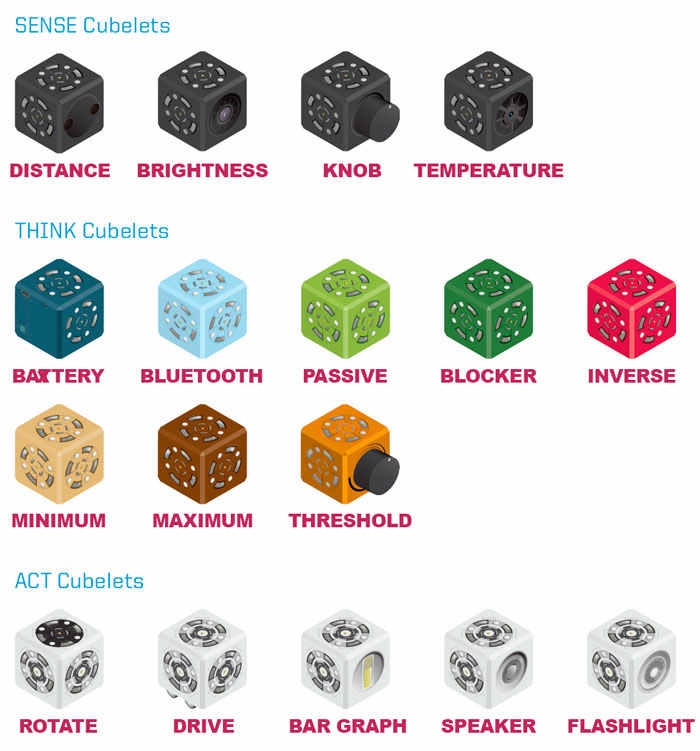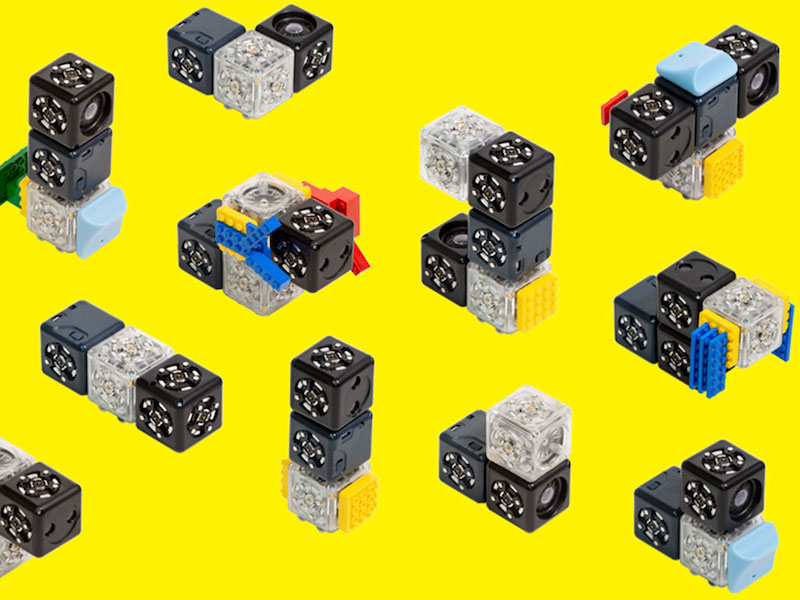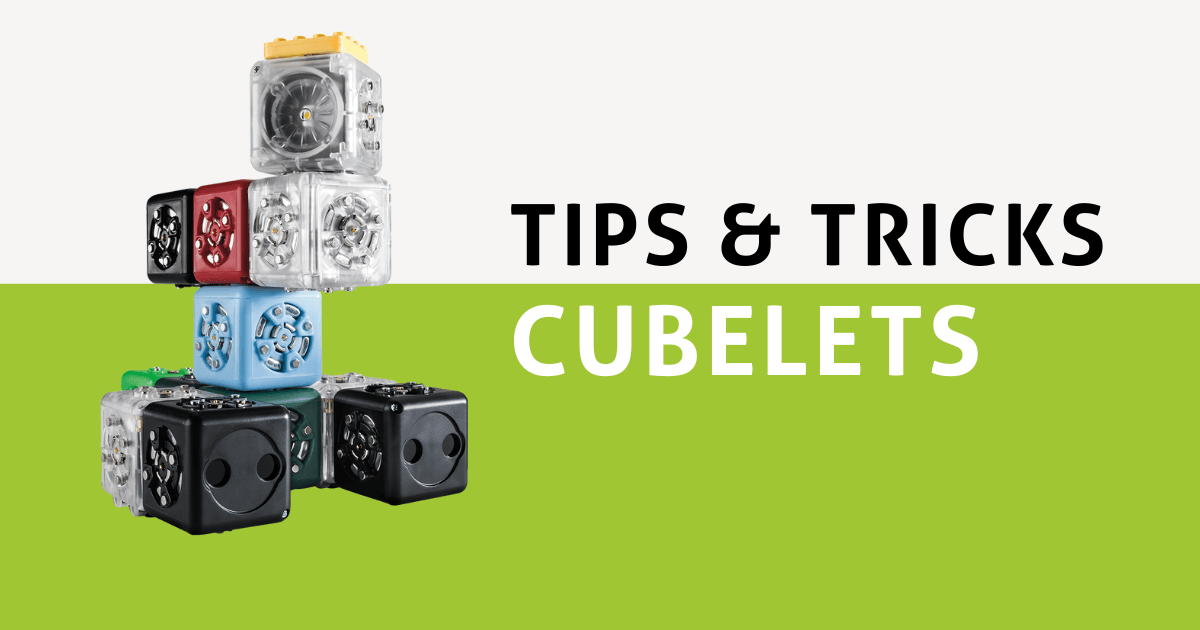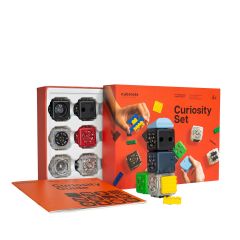Have you used building blocks? Probably. But Cubelets go beyond simple building blocks. Although they look like regular blocks, Cubelets include robotic software inside! By attaching Cubelets together magnetically, students can build their own robot structures. Because Cubelets include many different types of blocks, each combination creates a totally different robot. In this blog, we'll go over the popular Cubelets robotic systems from Modular Robotics, including initial set-up and other helpful classroom tips to help students get the most out of hands-on learning.
Recently, Modular Robotics revamped their Cubelets classroom kits. The largest of these, the Intrepid Inventors Pack, can support up to 12 groups of students with over 150 pieces. Smaller classrooms, though, can use the Motivated Makers Pack or the Clever Constructors Pack, which come with slightly fewer pieces. Depending on the size of the kit educators purchase, there will be a varying amount of Cubelets blocks and accessories. If you need help figuring out which size pack to purchase, contact us for a quote!
How Cubelets Blocks Work
Cubelets blocks can be grouped by their function, which is indicated by color. The navy blue blocks are power blocks; students will need at least one of these in each structure in order for it to operate. Kids should use the small switch on the bottom of these blocks to turn on the power. Just look for the green light that indicates the power is on.

The black blocks are referred to as Sense blocks. They pick up on things in the environment, like sound and light, for example, in order to set an operation in motion. Students can think of the Sense blocks like an input in a larger system. The system needs to detect an input, such as a certain level of light, in order to trigger an output. Then, Think blocks—colorful red or green blocks—analyze the inputs and pass the information on, prompting an output. But what kind of outputs are available? Clear blocks, called Act blocks, perform actions based on the inputs from the Sense and Think blocks. Act blocks can light up or drive, for example, when they receive a signal from one of the Sense blocks (an input). So, that makes the Act blocks output blocks. When they’re snapped together, all of these blocks create small robotic systems in which the components work together to achieve an exciting result!
Devices
The great thing about Cubelets is that students can use them in a number of ways. Much like the Edison Robot, students can learn with Cubelets whether they pair the blocks with a coding device or not. At the most basic level (Pre-K and kindergarten), kids can simply build with Cubelets and learn beginner engineering skills, such as construction integrity and problem solving. They can also use their hands, light, or sound as inputs to get their robotic machines to move around without the need for a screen.
As they progress into the elementary grades, what students can do with Cubelets expands. Thanks to the addition of the Bluetooth Cubelet, students can program Cubelets on the go. All they need to do is download the free Cubelets app, which is available for Apple and Android devices, and pair it with their Bluetooth Cubelet. Then, kids can control any Cubelets structure that includes at least one Bluetooth Cubelet! Here is a detailed set of instructions for pairing the Bluetooth Cubelet with a device.
Cubelets also has a Web-based Blockly programming language. Using this environment, kids can create programs with the popular Blockly language and transfer them to their Cubelets structures. The online coding environment includes opportunities for students to learn about logic, loops, variables, and more—all of which are important parts of programming. There are also tutorials available so both students and teachers can be sure they’re using Blockly effectively.

In the Classroom
One of the most common things educators ask us about any technology tool is what they can teach with it. When it comes to Cubelets, of course, robotics is the first thing that comes to mind. Since Cubelets are so versatile, however, they can also illustrate other important concepts, like math skills, engineering, design, critical thinking, logic, physics, and collaboration. They’re quite durable and designed to withstand the possibility of early elementary students dropping or stepping on them. As we alluded to earlier, students can use Cubelets as early as Pre-K. They’re designed to let kids as young as four years old start engineering and inventing on their own.
Helpful Hints
- Most Cubelets blocks have five connection faces on which kids can connect the blocks, and one special face, which identifies the function of that particular block.
- The battery block can be easily recharged by plugging it into the micro-USB power source.
- Sense blocks and Act blocks can be swapped to allow students to quickly replace the source they are using as their input or the result they are getting with their output.
- Each block in a Cubelets structure is constantly communicating with the other blocks. You can see green lights blinking, which indicate communication between the blocks.
- Arrangement of Cubelets blocks makes a big difference. This is important when it comes to choosing how to position Sense and Act blocks. A Cubelets robot will behave differently based on the assembly and order of the blocks.
To purchase a Cubelets kit or a Classroom Pack, we invite you to visit the Eduporium store. If you have any questions regarding Cubelets, feel free to contact us at support@eduporium.com and follow us on Twitter/X and Instagram for more EdTech Tips & Tricks!




